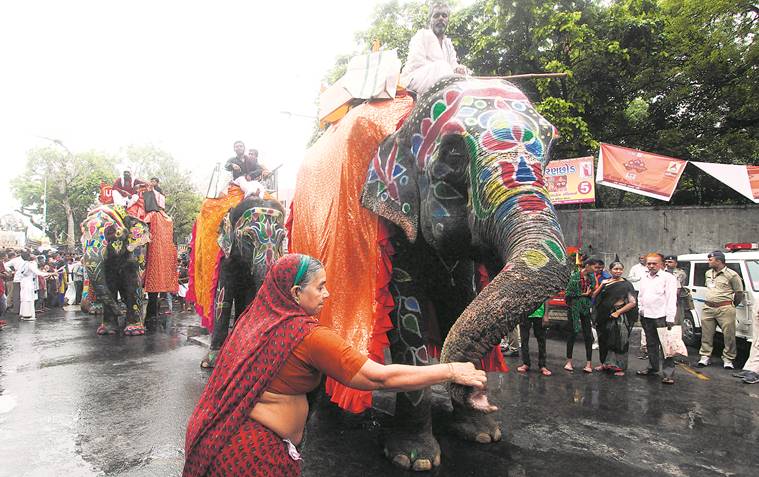- India
- International
Brown girl in the ring
The elephants from Assam didn’t join her. But like she has done for 30 years, Santoshi did her Rath Yatra duty, as ‘docile’ as required
 Santoshi during the Rath Yatra in Ahmedabad on July 4. Javed Raja
Santoshi during the Rath Yatra in Ahmedabad on July 4. Javed Raja
As she has done for the past 30 years, Santoshi stepped out on July 4, caparisoned and painted, to participate in the Lord Jagannath Rath Yatra procession in Ahmedabad. At 60, she is the oldest among the 17 elephants part of the temple trust, with one more added from a local mahant in the procession this year.
At the last minute, Assam put off sending four elephants more to join their group — if not walked with them — following a controversy over the tortuous long journey on wheels that would have entailed for the pachyderms.
Santoshi has cataract in her right eye and is kept chained at all times in a small compound opposite the Lord Jagannath Temple near Jamalpur Darwaza in Ahmedabad, with each animal only having a 3-4 ft radius space to move about.
Before Yatra day, Santoshi and the other elephants were examined by experts from the Health Department and nearby Kankaria Zoo, as their mahauts fed them jowar to keep them distracted and an official stood by with a tranquilizer, just in case.
Santoshi’s mahaut Tulsi Ram, a native of Ratlam in Madhya Pradesh, says feeding holds crucial clues. “When Santoshi is not well, she stops eating. That is our red flag… Fortunately, all these years, she has been very docile.”

Being docile is an important requirement of these elephants, with the annual Yatra procession requiring them to walk 18 km, amid a sea of devotees, vehicles, tableaux and ‘bhajan mandalis’. This year, over a million devotees were part of the festivities, watched over by 20,000 security personnel and teams from the zoo and Health Department, armed with a tranquilizer gun.
For three days leading up to the Yatra, all the elephants were stationed outside the temple for devotees to make their offerings. On regular days, one to two do so on rotation.
If they are confident of one elephant not posing any trouble, despite the gruelling schedule around the Yatra, it is Santoshi, says Ram Swaroop Das, the caretaker of the elephants at the temple. “Santoshi was brought to the temple by our maharaj (head priest Dilip Dasji Maharaj) three decades ago and she has been part of every procession since. Just like humans, elephants are intelligent beings and they have got used to the religious ceremonies now.”
Tulsi Ram, who has been with Santoshi for four years, is among the 20-odd mahauts looking after the temple elephants. They have no fixed salary. While food and lodging are provided, whatever they collect from devotees is their income. It is usually Rs 100-200 a day, and hence Yatra time is crucial.
A major part of a mahaut’s work involves feeding. An elephant eats over 150 kg of food daily. “Santoshi eats mostly jowar every day, along with fruits etc. However, her favourite are sugarcane and jaggery, fed by devotees,” Tulsi Ram says.
A lot of that diet comes in the form of alms, and hence, every day, 8-11 am, all the year around, the elephants are led across the city by their mahauts and a mahant each to fetch ‘dakshina’.
A few “smart tricks” go a long away. Rahul Singh, 20, originally from Jodhpur in Rajasthan, demonstrates an interaction between devotees and his elephant, Lakshmi (40). A middle-aged woman, with a baby girl in arms, approaches Lakshmi after Rahul has given the go-ahead. As Lakshmi lowers her trunk, the child puts a Rs 10 note and a Re 1 coin in it. The elephant swirls her trunk and puts the money in the front pocket of Rahul’s jacket. The child squeaks with amusement.
Smiling, Rahul says Lakshmi is the temple’s “star elephant”. Her face smeared with vermilion powder and a small bindi on her forehead, she is stationed opposite the temple’s main gate, and is a darling of the onlookers. “Devotees click selfies with her, a few feed her every day. The best part is that she recognises devotees, especially children,” says Rahul.
Explaining just how much profit elephants can bring them, Mahendra Naik, a fruitseller in Jamalpur, says, “Rest of the year, I station my cart at the Jamalpur vegetable market. However, from July 1 to July 4, I sell fruits to only devotees and every day, I do a business of Rs 1,000. Today, I sold 40 crates of bananas (each crate has around five dozen bananas).”
The caretakers believe the elephants at the temple share a unique bond. One of them, Jayshree, 35, was brought 25 years ago from Assam. Mahendra Jha, a trustee of Lord Jagannath temple, says they had requested for four elephants from Assam since three of their tuskers had died due to old age last year.
About what can be most stressful for the elephants, Rahul Singh says it is often the behaviour of humans. “Lakshmi can identify a drunkard if he approaches her… She starts growing impatient. But, unless provoked, animals never harm.”
Apr 16: Latest News
- 01
- 02
- 03
- 04
- 05






































